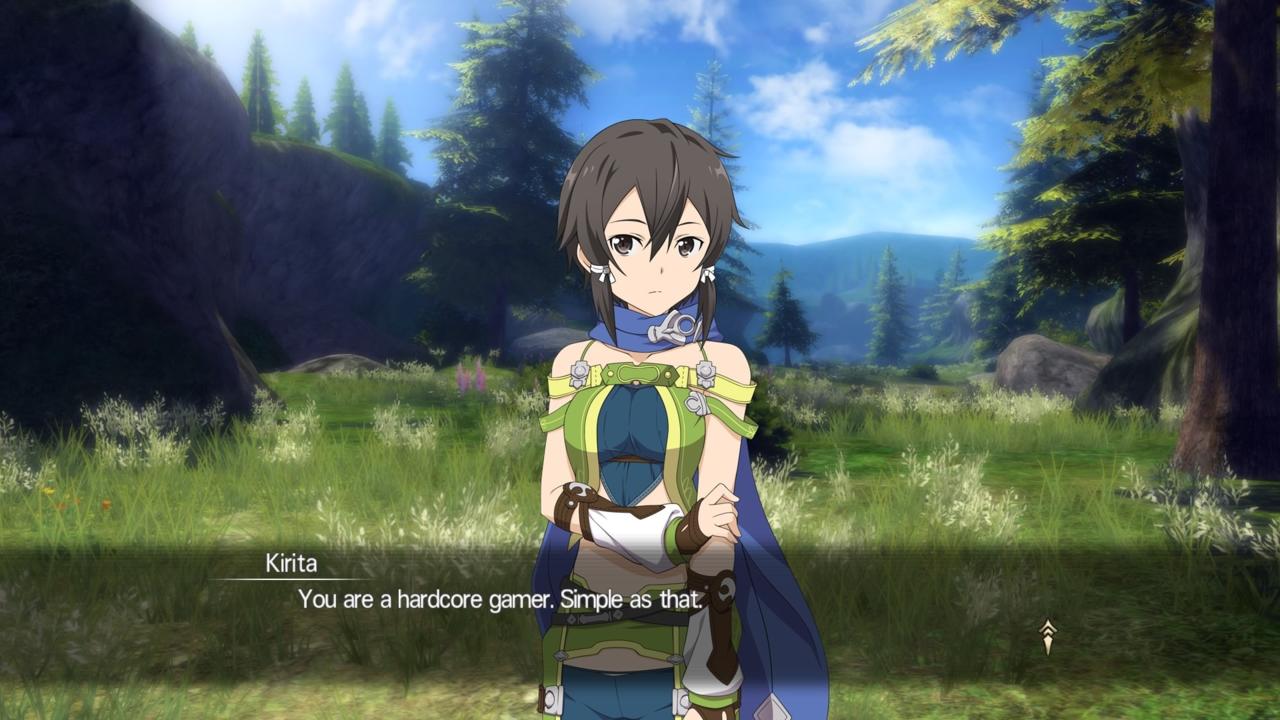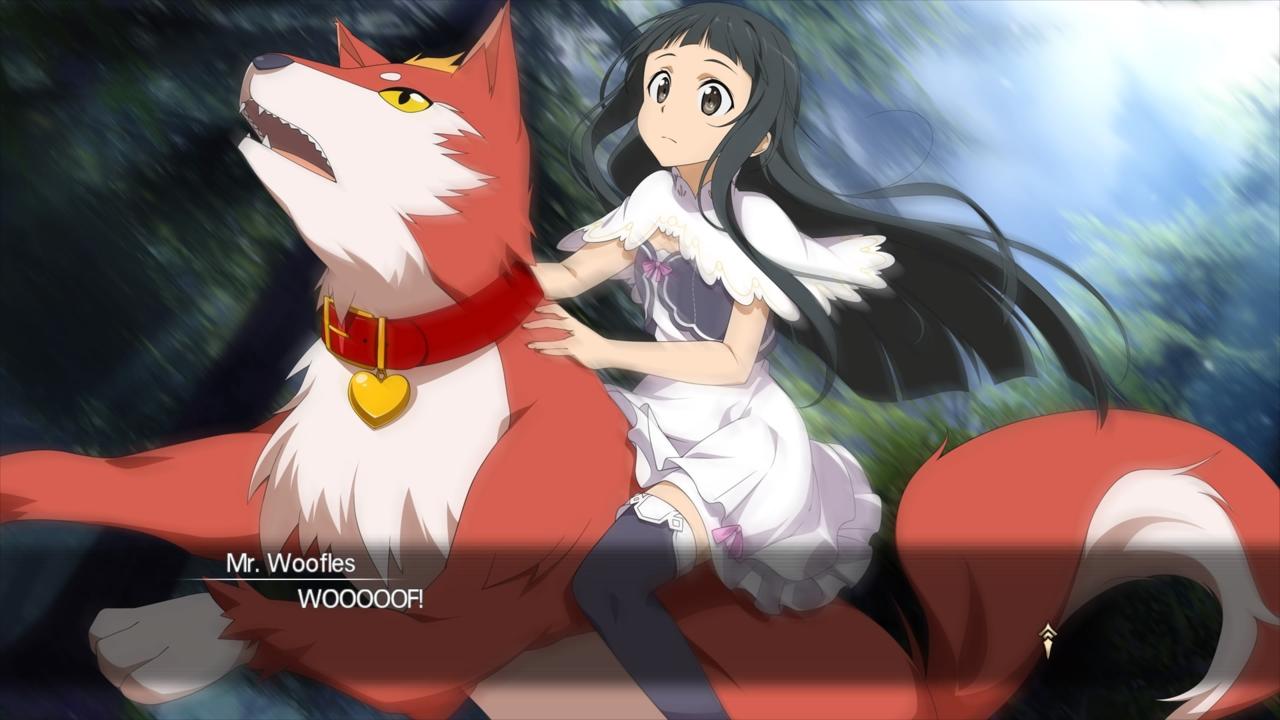There are a lot of things that I want to appreciate about Sword Art Online: Hollow Realization. I want to appreciate the marriage of RPG action and visual novel storytelling. I want to appreciate the way it candidly addresses the past trauma its characters have been through. I want to appreciate its devotion to imitating both the technical and social aspects of MMOs. But as much as I want to appreciate these things, I can’t just wave a magic wand and will myself to enjoy a game that exhausts me in the worst ways.
That said, if you only have a passing familiarity with the series on which it's based then Sword Art Online: Hollow Realization isn't necessarily the worst point at which to finally wade in. Rather than taking place in any previously used settings, Hollow Realization is set in the virtual world of Sword Art: Origin, a new game developed using assets from the titular in-fiction game of Sword Art Online.
While 2015's Sword Art Online: Lost Song let you choose from several playable characters, Hollow Realization doesn't. You embody the main character, Kirito, and even if you use the character creator to alter the look, gender, voice, and name of your avatar, you'll still see Kirito represented in illustrations and cutscenes. Other characters will likewise still refer to you as male when they talk, and you'll even still hear Kirito's voice in dialogue unless you specifically turn it off in the options menu. While the character customization is useful to distinguish yourself from others in multiplayer, it feels almost pointless in single-player.

As the name somewhat implies, Sword Art Online: Hollow Realization's combat is centered around melee weapons. They are your only option here, and although the inclusion of axes, spears, and maces means that you're not limited to swords alone, you can still expect to be up in your foe's face during combat. You can try out as many weapons and specializations as you like, and the game absolutely encourages this with skill trees that overlap and branch into each other, as well as skill points tied to raising weapon levels rather than your character level.
The key to success in a fight is not just your proficiency with your weapon, though. You'll venture out into the field with a party of three other characters--either Kirito's close buddies, friends made through fetch quests and socializing, or ally NPCs. These characters can be given commands to attack, heal, dodge, and so on, as well as crucially chaining skills for increased damage. You can also encourage your teammates when they do something you like, which influences their personality and makes them more likely to act similarly in the future.
Hollow Realization is also one of the buggiest games I've played all year. Completed events would pop back up in the list and vanish a few moments later, and cleared quest boards would still show an icon as if there was something left to turn in.
Combat can be entertaining at times, but it's not without its flaws. Once you have multiple skills and items that you want access to in a fight, you need to make the choice to either get very good at button combos or to use the skill palette--a window you navigate with the D-pad and select with the Circle button. That's all well and good, except the D-pad is also how you select which character you want to encourage, and the Circle button is your default method of parrying. Unless you’re willing to set a ton of combos and avoid the palette system altogether then this will inevitably be awkward. Equally awkward? The fact that for every weapon you try out, you need to place every individual skill and item in your palette anew, which makes experimenting with the different skill trees more tiring than it should be.
It's also infuriating how little a game riffing on the MMO genre has borrowed from it in terms of usability. The UI is curiously tiny with no obvious means of scaling it. Quests and events are also tracked in the menu, without any option to select one in particular to track onscreen while you're out and about. If you kill or collect something as part of one of the many, many fetch quests available, it will only announce your progress in minuscule text in the chat/log window in the lower left corner. Explanations for major events that you need to follow are also sparse. You might get specific directions as part of the story, but if you stop playing and come back looking for a refresher, you're likely to have nothing more than a few vague words to go on: “Keep exploring.”

Hollow Realization is also one of the buggiest games I've played all year. Completed events would pop back up in the list and vanish a few moments later, cleared quest boards would still show an icon as if there was something left to turn in, and the button used for basic attacks would occasionally stop responding until I jumped, which seemed to reset it. Then there was the big boss fight that ended with a cutscene, followed by utter blackness until the game was forcibly closed and relaunched from the PS4 menu. Most of these bugs were just weird foibles and mild inconveniences, but that one legitimately had me sweating.
The AI of both enemies and allies leaves a lot to be desired, too. One of the most familiar sights in Hollow Realization is an enemy standing perfectly still while you carve it to bits, staring or shuffling impotently until it finally falls. And there's nothing like seeing a party member standing in the path of a linear attack, yelling at them to dodge, and then watching them skip directly backward instead of to the side--leaving them still completely in the path of that same attack.
“You gotta me more careful,” one character told me. Another complained “took you look enough” when they were kept waiting. “Time to head back and fine her,” said someone who was definitely not intending to levee a small charge against another character for breaking the rules.
The game’s typos are just as annoying. “You gotta me more careful,” one character told me. Another complained “took you look enough” when they were kept waiting. “Time to head back and fine her,” said someone who was definitely not intending to levee a small charge against another character for breaking the rules. This would be a lot more forgivable if not for what Hollow Realization truly is: half RPG and half visual novel. That's an idea that's worth appreciation, especially in a game that's as interested in examining personal relationships and the effects of shared trauma as this one, but the execution is a mess. And there are few levels of video game hell deeper than the hell of poorly written visual novels.
It's also a perfect example of why “show, don't tell” is such vital advice for writers across genres. The general pattern of playing Hollow Realization involves running out into the world, clearing a few maps, and then coming back to check in with your pals. They'll pop up in front of set backgrounds, talking and describing various scenes. There are loads of instances like this representing various points in Kirito's relationships with the characters, but what they all have in common is that they take a long time to say and do very little.

Some of these off-camera quests did actually sound a lot more interesting than what the game has you doing, but the format keeps you so far removed that these little events hardly felt worthwhile. They'll often take you out to fight a boss or do a quest, but at no point will you run around or enter combat. You typically won't even see the enemies or items you're after. There's a lot of “Hyaa!” and “Grraaah!” and screen-shake effects, You're told something cool happened, everyone's excited, the end.
And then, only occasionally, the game will grace you with a partially clothed butt or some soapy elven breasts as a reward. Sword Art Online has a reputation for its fan service, after all, so if you want to see the same picture of an elf lady taking a bath on three separate occasions, you're in luck.
Sword Art Online: Hollow Realization tries to do a lot of things, but it doesn't end up doing any of them terribly well. Every subtle good idea that it has is countered by a glaring shortfall. The open and flexible skill system is held back by its clumsy implementation, and the winding faux-virtual world by how little anything of interest actually occurs in it. That’s without even touching the fact that a game pushing the premise that A.I. and NPCs should be respected (tell me more!) makes your primary interactions with those types of characters a tedious and neverending series of fetchquests (nevermind!) There are hints to what Sword Art Online: Hollow Realization is trying to be—it just never gets there.





























